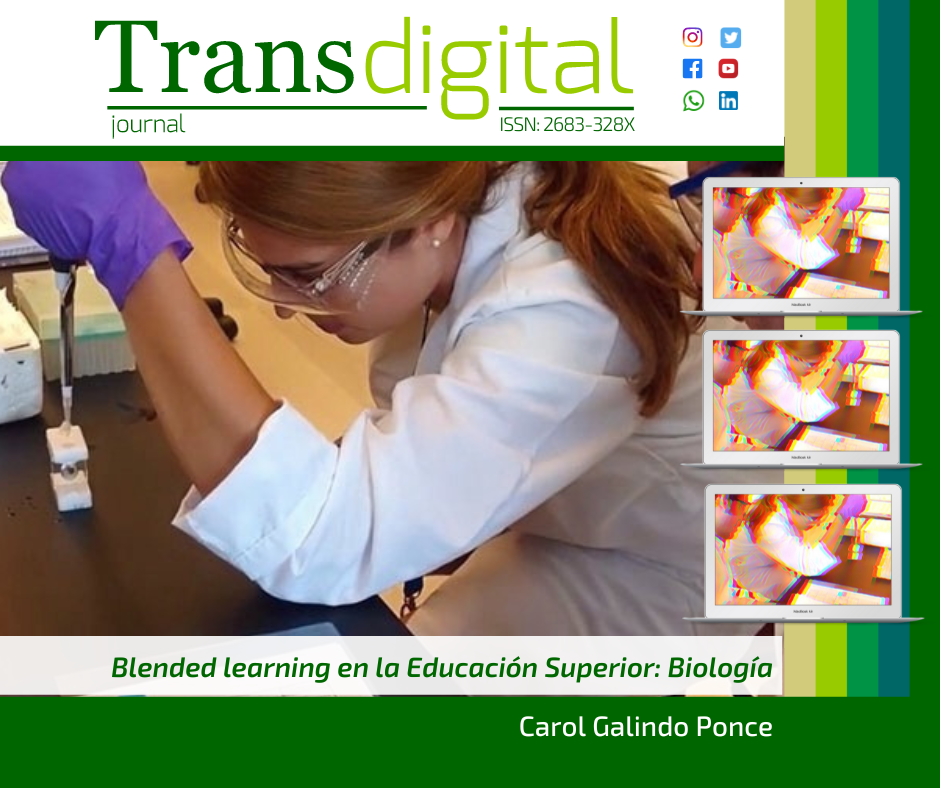Blended learning in Higher Education: Biology
DOI:
https://doi.org/10.56162/transdigital120Keywords:
learning method, blended learning, biology, higher educationAbstract
In the present study, the literature of the last six years regarding Blended Learning (BL) applied in the teaching of Biology in higher education was reviewed, with special attention in times of health emergencies such as the SARS-CoV-2 pandemic. The search method was followed in metasearch engines using the algorithm (Blended learning) AND (biology) AND (higher education) to obtain literature from 2016 to 2022. The information obtained was analysed using the narrative method, where different experiences were contrasted. reported by the students, teachers and schools involved. In addition to compiling the findings of each investigation, from the type of investigation involved, the country where it was carried out, its stated objectives, the sample size, the subjects where it was applied and the results they reported, and the advantages and disadvantages that this model represents when applied in the teaching of Biology. It was concluded that the model is still under development worldwide and is applicable as a pedagogical method. It can be used to teach any subject in the biology career, as long as there is good ICT management by the teacher and the students. In addition, research in this regard is scarce for the Latin American region.
References
Alsalhi, N. R., Eltahir, M.E. y Al-Qatawneh, S.S. (2019). The effect of blended learning on the achievement of ninth grade students in science and their attitudes towards its use. Heliyon, 5(9), 1-11. https://doi.org/10.1016/j.heliyon.2019.e02424
American Association for the advancement of science (2011). Vision and Change in Undergraduate Biology education a call to action. https://live-visionandchange.pantheonsite.io/wp-content/uploads/2011/03/Revised-Vision-and-Change-Final-Report.pdf
Andrade-Cázares, R. A., Carpio-Domínguez, R. E., y Sánchez-Luna, M. (2022). La educación mediada por las Tecnologías durante la pandemia por COVID-19, desde la mirada de los estudiantes: Aprendizajes y experiencias. Universidad-Verdad, 80, 112–131. https://doi.org/10.33324/uv.vi80.518
Bliuc, A. M., Goodyear, P., & Ellis, R. A. (2007). Research focus and methodological choices in studies into students’ experiences of blended learning in higher education. The Internet and Higher Education, 10(4), 231–244. https://doi.org/10.1016/j.iheduc.2007.08.001
Cabero, A. J., y Llorente C. M. (2008). Del e-learning al blended learning: nuevas acciones educativas. Quaderns Digitals, 51, 1-6.
Cifuentes-Faura, J. (2020). Docencia online y Covid-19: la necesidad de reinventarse. Revista de Estilos de Aprendizaje, 13 (Núm. Especial), 115-127. http://revistaestilosdeaprendizaje.com/article/view/2149
Chow, F., Gomes, C.C. y Ribeiro, M. M. (2021). Do ensino remoto emergencial ao ensino híbrido no curso de ciências biológicas: a nossa visão a partir do Instituto de Biociências da Universidade de São Paulo (IB-USP). Medicina (Ribeirão Preto), 54(Supl 1), 1-7. https://doi.org/10.11606/issn.2176-7262.rmrp.2021.185554
CUAIEED. (s.f.). Glosario de modalidades educativas. Educación remota de emergencia. https://recrea.cuaieed.unam.mx/glosario/Educaci%C3%B3n_remota_de_emergencia#:~:text=Definici%C3%B3n,comunicaci%C3%B3n%20entre%20profesores%20y%20alumnos
Graham R. P. (2005). Multimedia in Biochemistry and Molecular Biology Education Commentary: Curtis Bonk about Blended Learning. Biochemistry and Molecular Biology Education, 33(4), p. 309. https://iubmb-onlinelibrary-wiley-com.pbidi.unam.mx:2443/doi/epdf/10.1002/bmb.2005.49403304309
Golding, W. S. (2018). An Exploratory Case Study of a Community College System in a New England State: Community College Science Faculty Reports Regarding Effective Instruction in Traditional and Hybrid Formats (Tesis doctoral). University of Hartford, USA.
Harahap, F., Nasution, N. E. A., and Manurung, B. (2019). The Effect of Blended Learning on Student's Learning Achievement and Science Process Skills in Plant Tissue Culture Course. International Journal of Instruction, 12(1), 521-538. https://doi.org/doi:10.29333/iji.2019.12134a
Hodges, C., Moore, S., Lockee, B., Torrey, T. & Bond, A. (2020) The Difference Between Emergency Remote Teaching and Online Learning. Educause. https://er.educause.edu/articles/2020/3/the-difference-between-emergency-remote-teaching-and-online-learning
Kritzinger, A., Lemmens, J-C., and Potgieter, M. (2021). Effectiveness of the blended design of a first-year biology course. International Journal of Science Education, 43(12), 2025-2043. https://doi.org/doi:10.1080/09500693.2021.1950942
Morán, L. (2012). Blended Learning. Desafío y oportunidad para la educación actual. EDUTEC, Revista Electrónica de Tecnología Educativa. Núm. 39/Marzo 2012. 1-19. Recuperado de https://www.edutec.es/revista/index.php/edutec-e/article/view/371/108
Olpak, Y.Z. and Ates, H. (2018). Pre-service Science Teachers’ Perceptions toward Additional Instructional Strategies in Biology Laboratory Applications: Blended Learning. Science Education International, 29(2), 88-95. Recuperado de https://files.eric.ed.gov/fulltext/EJ1184776.pdf
Paredes-Chacín, A., Inciarte, A. y Walles-Peñaloza, D. (2020). Educación superior e investigación en Latinoamérica: Transición al uso de tecnologías digitales por Covid-19. Revista de Ciencias Sociales (Ve), XXVI(3), 98-117. https://repositorio.cuc.edu.co/bitstream/handle/11323/7067/Educaci%C3%B3n%20superior%20e%20investigaci%C3%B3n%20en.pdf?sequence=1&isAllowed=y
Padilla-Ramírez, J. R., Varona, G. D. E., Silva, R. A. y Stanford C. S. (2010). B-learning, tendencia en la educación actual: Una experiencia en el estudio de las Ciencias Biológicas. Organización de los Estados Americanos, Portal Educativo de las Américas. https://recursos.educoas.org/publicaciones/b-learning-tendencia-en-la-educaci-n-actual-una-experiencia-en-el-estudio-de-las
Semanate-Quiñonez, H., Upegui-Valencia, A. y Upequi-Valencia, M. (2021). Blended learning, avances y tendencias en la educación superior: una aproximación a la literatura. Informador Técnico, 86(1), 30 - 52. https://doi.org/10.23850/22565035.3705
Scoggins, M. J. (2018). Student success in distance learning and traditional Classroom environments at the community college level in Introduction to biology courses (Tesis doctoral). University of South Alabama, USA.
Stockwell BR, Stockwell MS, Cennamo M & Jiang E (2015) Blended Learning Improves Science Education. Cell 162, 933–936. https://doi.org/10.1016/j.cell.2015.08.009
Sugiharto, B., Corebima, A. D., Susilo, H. and Ibrohim. (2019). The Pre-Service Biology Teacher Readiness in Blended Collaborative Problem Based Learning (BCPBL). International Journal of Instruction, 12(4), 113-130. https://eric.ed.gov/?id=EJ1230042
Tahir, I., van Mierlo, V., Radauskas, V., Yeung, W., Tracey, A., y Silva, R. (2022). Blended learning in a biology classroom: Pre?pandemic insights for post?pandemic instructional strategies. FEBS Open Bio. https://doi.org/10.1002/2211-5463.13421
UNESCO. (2020). COVID-19 crisis and curriculum: Sustaining quality outcomes in the context of remote learning. (Education Sector issue notes n° 4.2). https://unesdoc.unesco.org/ark:/48223/pf0000373273

Downloads
Autor de correspondencia
El autor de correspodencia se identifica con el siguiente símbolo: *Published
How to Cite
License
Copyright (c) 2022 Carol Galindo Ponce

This work is licensed under a Creative Commons Attribution 4.0 International License.
All articles in Transdigital are licensed under a Creative Commons Attribution 4.0 International License. Authors hold the copyright and retain publishing rights without restrictions.









